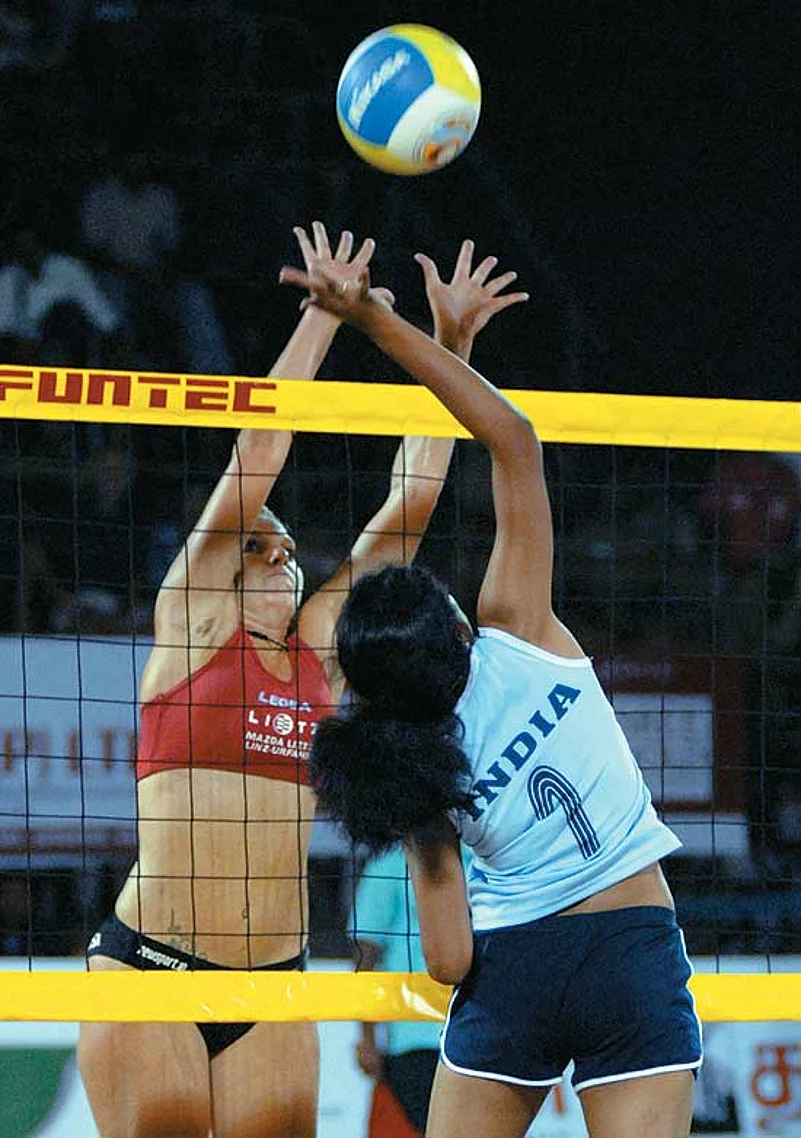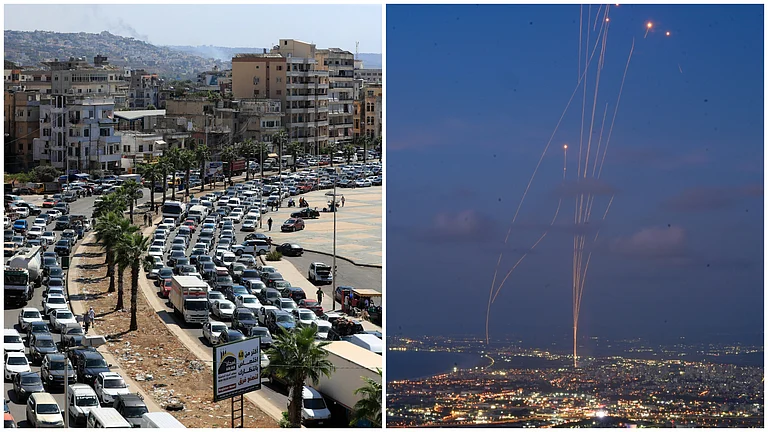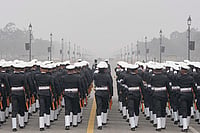A Small Storm By The Sea...
- Second edition of the FIVB Challenger Beach Volleyball Championship to be held in Chennai
- 32 men’s and 24 women’s teams to play matches from Sept 27-Oct 2
- Besides India, teams are expected from at least 18 nations. As host nation, India will be allowed to field 3 men’s and 3 women’s teams.
- Total prize money: $70,000—$40,000 for the men’s event, and $30,000 for the women’s event
- In the first edition, which was also held in Chennai, in July 2008, Indian women played only after being allowed to wear shorts and sleeveless T-shirts instead of the bikini shorts and tank tops that FIVB has prescribed since 1998
- This year, women players from Goa have agreed to abide by the international dress code
***
When athletic young women in bikinis play beach volleyball, springing and leaping, diving and stretching and sprightly tumbling, using hands and forearms to keep the ball off the sand on their side of the net in well-rehearsed tactics, waiting for a chance to rocket up, arch back and spike it down in sharp angles to fox the opposite side, what is it the cheering spectators are really watching? Well, what were you, dear reader, thinking of as you went through that last sentence?
A little sharp practice there, we admit. But the answer does depend on where you come from or ordinarily reside, whether you are a man or a woman, what you are used to seeing women in, what you know, do not know, or care to appreciate about this strenuous game involving quick reflexes and teamwork. In Chennai, which is hosting the FIVB Challenger Beach Volleyball Championship from September 27-October 2—with men’s and women’s teams playing—there are those who refuse to believe the crowds swarming to the Elliot’s beach venue will be there to watch the game—and not to ogle at the women players.
In fact, at one level it’s a coup that the championship is at all being organised in this fast-changing but still largely conservative city, where young women wearing half-sari ensembles, jasmine in their well-oiled plaits, are a common sight and where the festive margazhi masam sees connoisseurs crowding the sabhas to imbibe Carnatic music. Even more difficult, then, to believe it’s being held here for the second time in a row, when the hot topic last time was the dress code for women players. The FIVB, the international federation for volleyball, specifies bikini-styled shorts and tank-tops that leave the midriff bare. But the Indian team played in the event only after its players were allowed to wear longer shorts and sleeveless T-shirts in deference to national and local sensibilities.
A.J. Martin Sudhakar blames the media for stoking a controversy over the dress code last time, when the focus could have been on international participation, the prize money, the enthusiasm such an event generates. This year there are 32 men’s and 24 women’s teams participating, from Canada, Brazil, Australia, New Zealand, Russia, England, Germany, Austria, Italy, Spain, Denmark, Thailand, China, Japan, the Czech Republic and the US. The prize money is $40,000 for men, $30,000 for women. One difference this year, Sudhakar said at a press conference, is that women players from Goa are sticking to FIVB’s dress code. That annoucement was bound to generate buzz, if not controversy.
There are women players who find it hard to believe Indian players “will go against our culture”, and a former national player (male) even says they won’t play in bikinis because “after all, these girls have to get married”. Equally so, there are players like Kanaka Mahalakshmi, a player from Andhra Pradesh, who takes a practical view. “Every sport has a talking point, and bikinis happen to be the talking point of beach volleyball,” she says. It bothers her that there’s a controversy over the outfit, and that the FIVB rules come in the way of Indian players making headway in this variant of volleyball. “An Australian player told me she’d worn bikinis right from childhood and was therefore comfortable in them,” says Kanaka. “But Indian girls are not.” Aware of Indian attitudes to women’s attire in public, Zoe Chater of the French team had tried to build bridges during the last edition, saying, “We don’t mean to offend anyone. We are here to play.”
But there has been enough change in Chennai to suggest that the bikinis and white skin will attract no more—and no less—attention than in any other city of India. Clubbing and trips to the discotheques are as much the fashion as being at the sabha, sushi as trendy as meals on banana leaves—it all depends on the occasion. So, shouldn’t bikinis be appropriate enough for the Indian beach volleyball team in Chennai?
Kanaka, perhaps, has a clue. “The crowds were very positive and cheered whenever a team scored a point,” she says. “I don’t know Tamil, so I can’t say if there were lewd comments. But I never felt bad, for although there were more men among the spectators, there were enough families and children too.”
There was some objection from political groups last time, but more to seek attention and get photo-ops rather than to disrupt the event. Four women leaders of the bjp had handed a memorandum to the police commissioner, complaining that the attire of some players was “indecent”, while some Hindu Makkal Katchi activists had courted arrest. This time, too, no disruption is likely: some leaders of the ruling DMK are part of the organising committee and are said to be making arrangements for crowd control and security under their own supervision.
There could perhaps be a change in venue this year, with the event moving to Marina beach, a public locality, if the municipal corporation and the police commissioner grant permission. That would please residents of Besant Nagar and other colonies near Elliot’s beach, which had to bear with blaring loudspeakers during the last championship and undergo several security checks before reaching their own homes.
At as less as Rs 50 per season ticket, the last event had drawn a crowd of about 5,000. Another 10,000 had jostled to watch the matches on giant screens put up on the beachside. Much larger numbers are expected this year. Will the Goa girls’ decision to play in bikinis prove a contributory factor? Let that be decided by those who go to beach volleyball tournaments not to watch the game or the girls, but to study sociodynamics.


























